Out & About The Bay – by Jillian Humphreys

The Boys Are Back In Town
Fleet Week has always been an event that draws crowds from all over to the waters and shorelines of the San Francisco Bay. The now annual event was started in 1981 by then mayor of San Francisco, Dianne Feinstein who now sits as an Honorary Co-chair to it. I enjoyed the festivities this year on the shoreline by the St. Francis Yacht Club on Sunday while some of my friends enjoyed it from the water. Lee Marchand and Susan Ollis who keep their 53-foot Californian in the Bay at Emery Cove Yacht Harbor had a boat load of their friends on board for Saturday’s air show. Watching on the SF shoreline is spectacular to say the least, but there is no substitution for viewing from the water. Eric Jones of Sea Valor had his crew and guests on the water and word has it that Blair Hake and his wife Mary who were fresh in from their Hawaiian vacation the day before were on board as well.
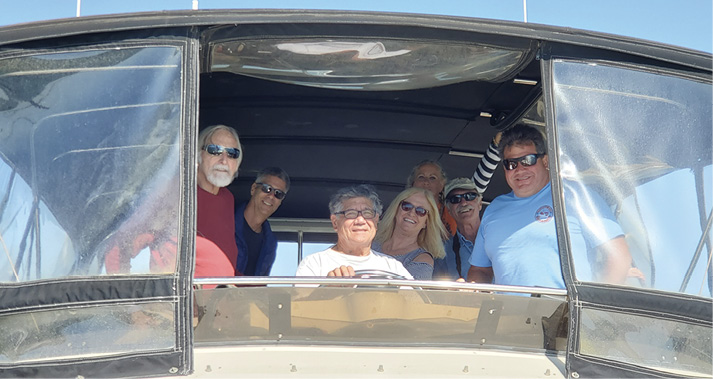
Spectators were in luck since the crazy windstorm did not postpone the festivities. It did not arrive until the early hours on Monday morning.

The main attraction for visitors is the U.S. Navy’s Blue Angels, but many people do not know why and when they started participating in this annual event. The Navy thought that a flight demonstration team was a way to stay in the public eye after the war in the Pacific had started. A group of veteran fighter pilots started the first air shows in propeller driven aircrafts that they used in the war. The name “Blue Angels” came from a pilot who happened to see the name in the New Yorker magazine. The 1950s is when the six-plane formation was born, and this is while the F-9 Cougar and F-11 Tiger aircrafts were flown. The F/A-18 Hornets that were first introduced in 1986 as part of the 40th anniversary celebration are quite different from the F/A-18 Super Hornets flown today. The Boeing built Super Hornet can reach speeds of up to 1,190 mph. However, during their airshows the fastest speed obtained is right around 700 mph while performing the sneak pass run. With the speed being slightly below Mach 1 and under the point of breaking the sound barrier it is actually the most spectacular visual of the show as the solo pilot flies with momentary bursts of the vapor cone forming around the mid to tail section of the aircraft. This is quite the opposite of their slowest maneuver which is called the Section High Alpha Pass where two of these supersonic jets slow down to 125 mph and fly the length of the flight box with the jet’s nose pointed upwards at 45 degrees. When you watch this move you would suspect that they are crawling since it is hard to fathom that they are going so fast and look so slow. The whole program is a thrill of aerobatic talent, nerve and skill, but none more so than those in their moves that require the jets to get as close as 18 inches from each other while performing some of the more skillfully executed exercises.
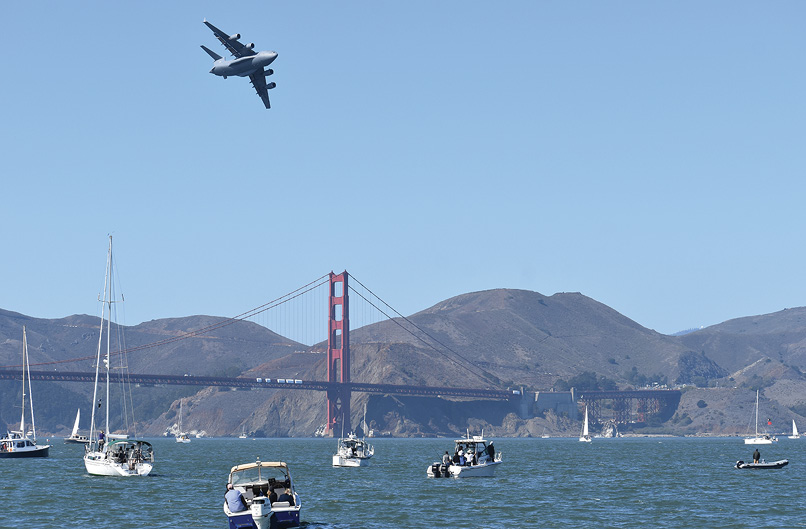
In 1949, three years after the first Blue Angels air show, it became necessary for the team to operate a support aircraft to move personnel and equipment between shows. The support aircrafts have included the Douglas R4D Sky Train, Curtiss R5C Commando, Douglas R5D Skymaster and the Lockheed C-121 Super Constellation. A Lockheed Martin C-130, affectionately known as “Fat Albert” which was acquired in 1970 is still in use today.
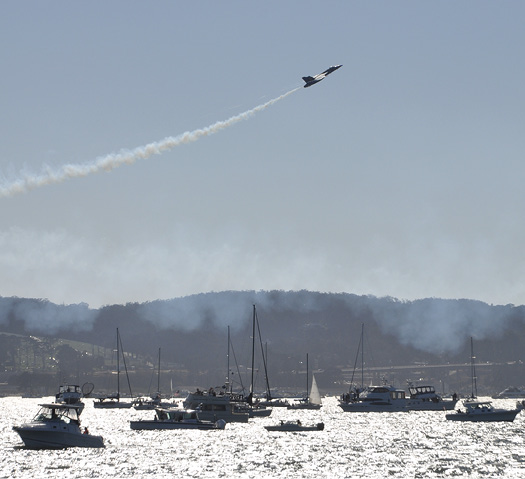
The ships that came into port to enjoy the annual festivities this year were the USS Rushmore, USS Michael Monsoor, USS John S McCain, USS Shoup and USCGC Robert Ward. Each of them has unique histories as they have not attended the San Francisco Fleet Week in recent years.
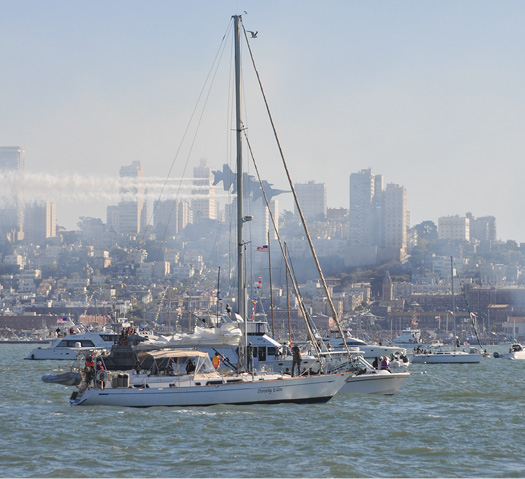
The USS Rushmore is in the Whidbey Island class and part of the Pacific Fleet. The ship was launched in May of 1989 and has a larger area for the storage of weapons and other equipment. During her first deployment she spearheaded the largest humanitarian operation in military history, Restore Hope. Restore Hope was designed to provide medical aid along with food to the Somalian people in the early 1990s. In recent years the USS Rushmore made headlines for rescuing a total of 65 people on a makeshift life raft when their ferry capsized in Makassar Strait in Indonesia. Future plans for her include being retired and placed in the Out of Commission Reserve in 2024. Until then she will spend her time in San Diego. The USS Michael Monsoor is also in San Diego. The USS Michael Monsoor belongs to the Zumwalt class as a guided missile destroyer. The main weapons on the vessel are a pair of Advanced Gun Systems (AGS). The U.S. Navy canceled the ammunition procurement program for the only type of ammunition it can use, so the AGS cannot provide naval gunfire support. Since then, the Zumwalt class has been repurposed for surface warfare since it is still a relatively young ship being that it was launched in 2016.
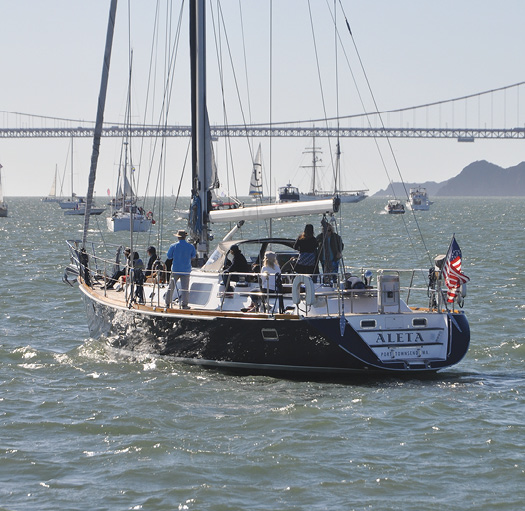
The USS John S McCain wasn’t actually named after the late senator a short time before his passing, but rather after his father and grandfather who also served in the U.S. Navy. The vessel was launched in 1992 out of Maine and served in the Gulf War. In July of 2009 she was part of a goodwill tour where she was docked at Yokohama’s international passenger terminal and was open for tours for the public. The USS John S McCain has been involved with numerous international relief efforts as well, including the Tohoku earthquake and tsunami, along with aircraft carrier USS Ronald Reagan in 2011. The vessel was reassigned a home port in Everett, Washington this past September. The other naval ship at this year’s Fleet Week was the USS Shoup which celebrates its 21st birthday in 2021. In 2011 the USS Shoup provided assistance to the South Korean Navy with the recapture of a chemical tanker. The tanker’s captain was evacuated by a helicopter provided by the USS Shoup since he had been shot by pirates in the Arabian Sea and needed medical treatment for his injuries.
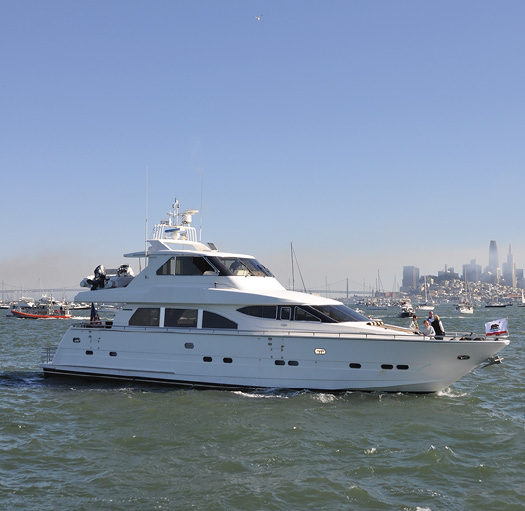
Every year ships of all sorts of backgrounds come to join the festivities that we offer as part of our local Fleet Week. This event is something that kids of all ages come out to enjoy, and every year the U.S. Navy does not disappoint. I recommend that everyone celebrate Fleet Week. It is not just supporting San Francisco, but also our military. I hope that come Fleet Week 2022 you are able to get out and enjoy it whether it be on land at one of the many excellent vistas or by water. If you have the room, invite someone who would not have had the opportunity to view it from the water otherwise.

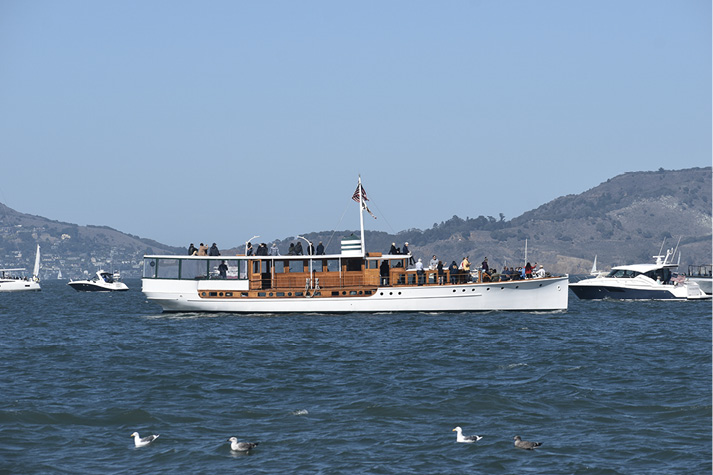
Racing Rounding Up
The Express 27 Nationals came to San Francisco Bay again this year with the three-day event being hosted by the Richmond Yacht Club. Winds were good and luckily Karl the Fog held off until racing was completed each day before rolling in. The fleet is still one of the most competitive fleets in the area. The Express 27 National Champion of 2021 is local sailor Will Paxton on Motorcycle Irene were followed by Get Happy and Magic Bus. Get Happy and Magic Bus both won against Motorcycle Irene in the Delta Ditch earlier this year. It will be interesting to see which of these top competitors will win at the Great Pumpkin Regatta in late October since that is their last race of the year.
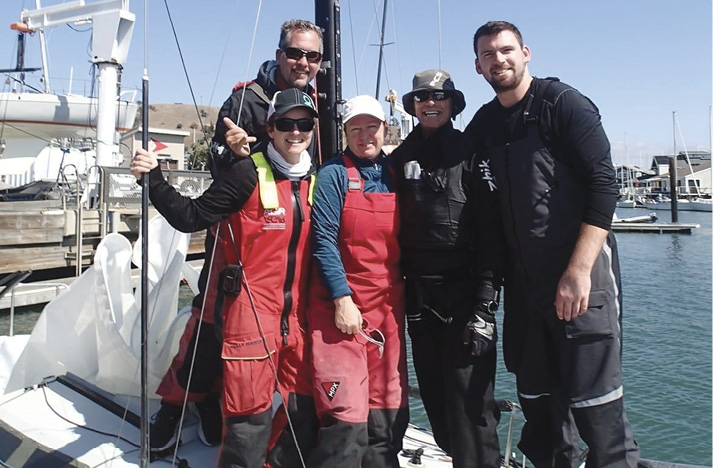
The Express 37 Nationals hosted by Berkeley Yacht Club also took place since most of the boats were still in the area after the Rolex Big Boat Series last month. Every boat was eager to win against RBBS class winner Shawn Ivie’s Limitless from Southern California, but the wind was on his side for day one. Limitless held onto her lead until race 2 of day 2 as it was a long-distance course taking off from Olympic Circle, over to Harding Rock, just northwest of Alcatraz, then to Blossom Rock, off of Yerba Buena Island, and finishing at the Olympic Circle. Andy Schwenk, a Washington State native took the bullet on Spindrift V. The racers enjoyed a paella dinner in the evening as they talked strategy for the final races the next day. Congratulations to Shawn and the crew of Limitless for their win for the third consecutive nationals, followed by Spindrift V and Elan.
The ninth annual Red Bra Regatta took place at the South Beach Yacht Club. The Red Bra Regatta is an all-women event that takes place in October in the waters of the South Bay since the wind seems to be less intense. Women love this event since it is all about women’s empowerment. Jocelyn Nash once said to me, “I can do more on a sailboat than make sandwiches and I can prove it.” Jocelyn passed away in the spring of 2020 and is a woman that many sailors looked up to in the Bay Area. Over 20 boats signed up for this year’s event and enjoyed two races on the third weekend of October.
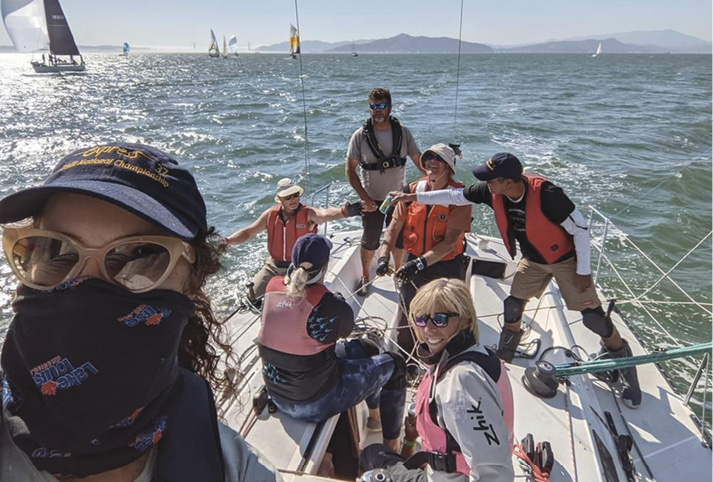
The Islander 36 fleet of the San Francisco Bay also held their Nationals out of Golden Gate Yacht Club. The Islander 36 is a very popular boat which shows when the fleet of eight comes out to play. Tom Schoenhair and his crew on Windwalker took the bullet followed by Renaissance of Tahoe Vista and Highlighter.
As the year wraps up, the wind comes to a standstill and the racing in the Bay Area becomes sparse, I look for new fun adventures around the Bay to enjoy until the wind returns.
Richardson Bay, The Past And The Future
Richardson Bay has been on a mission to clean up the area of liveaboards and other debris and get it back to its roots. Before Richardson Bay can do any of that we must understand why it is important to do so and how it is being accomplished. Sometimes abandoned vessels are seen from time to time, but Richardson Bay is becoming the ideal place to drop anchor and leave.
Richardson Bay is a part of the San Francisco Bay, located between Sausalito and Tiburon. It was first acquired as a sanctuary in the 1960s and the 911 acres of marshy wetland was named after 19th century boat builder and sea captain, Mr. William Richardson. Richardson taught carpentry, boat building and navigation at Mission Dolores, a local Catholic church. He also served as captain of the port of San Francisco, and although it was meant to be a trading post, Richardson built the first significant residence in the city of San Francisco. The name of the Bay was originally Richardson’s Bay, but on maps and in government databases the name appears as Richardson Bay since the U.S. Board of Geographic Names opposes the use of apostrophes.

The ideal place for any birder is Richardson’s Bay as it is a bird’s paradise. The Bay sees migratory visitors every winter, many of which utilize the mudflats and marsh. Migrating birds that winter regularly at Richardson’s Bay include sandpipers, American avocet, dunlin, greater yellowlegs, willet and dowitchers, but do keep in mind that these are not all of the birds. The sandpiper is the smallest shorebird that migrates to the area, where as the dowitchers are medium size shorebirds and the greater yellowlegs are some of the largest shorebirds to visit the area. In 2014 the black oystercatchers were spotted nesting on Aramburu Island, an island in Richardson’s Bay. The black oystercatcher has been on the endangered species list even though the global population is not in immediate danger.
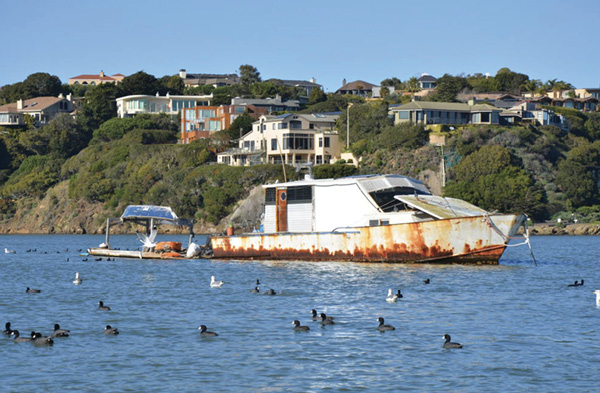
Boating in Richardson’s Bay is limited to mostly kayaks and paddle boards, but some smaller vessels can handle the depth of the water in the area. Also, the bay nearly closes entirely in the winter for six months to provide protection for the migratory birds. Richardson’s Bay joins the San Francisco Bay and Raccoon Straits as that is where the water depth increases from 20 to nearly 100 feet almost immediately crossing over the boundary. This sudden drop in depth is what causes the agitated waters in this area of the SF Bay.
Migrating birds are not the only tenants of Richardson’s Bay. For decades people have been anchoring in the area for a night or two, but some stay a bit longer and it is becoming an ever-growing problem. Imagine living on the water for free. This is the big attraction for individuals to take up long-term residence on Richardson’s Bay. The waters are calmer compared to other anchorages around the San Francisco Bay.
In 2020 Richardson’s Bay had about 130 vessels that were not complying to the regulations they must follow to continue to be an “anchor-out.” During the pandemic, more and more people came to Richardson’s Bay, dropped anchor and made a makeshift home for themselves. There is always a way to enjoy life on the hook and not be in jeopardy of being approached by the Richardson’s Bay Regional Agency.
Boaters are welcome to stay longer than 72 hours if they are in preparation stages for going offshore or repairing their vessel. The Richardson’s Bay Regional Agency asks that persons wishing to do this complete an application and contact the agency directly as well. All vessels wishing to stay within these conditions also need to provide proof of insurance, which will ensure that they will be granted an anchoring permit. All anchor-outs must be outside the Richardson Bay Audubon Sanctuary and small boat channels.
Boaters must be cautious when anchoring out since the Bay tends to get shallower in some parts compared to others. It averages less than four feet at mean low. The Bay floor is mostly made up of mud so you may want to rethink your anchor choice before deploying. The Bay is known for a six-foot tidal swing. Boaters will want to be prepared by using the adequate amount of scope to accommodate. Another thing to keep in mind is the potential for the wind to pick up. In the summer the winds can clock around from west to north pretty quickly, and one should always be prepared. Boaters anchoring out in Richardson’s Bay over the years have impacted the eelgrass that grows on the Bay floor with their anchors and chains. The eelgrass beds in Richardson’s Bay provide a habitat for Dungeness crab and Pacific herring and assist in reducing coastal erosion.
While staying in Richardson’s Bay there is a strict “No Discharge Zone” policy as the number of local pump out opportunities including a mobile service assist in keeping the Richardson Bay Audubon Sanctuary a sanctuary. This is why the recent invasion of “anchor outs” that are not legally staying in the area have become a concern. When one makes their makeshift home on their boat illegally, it is difficult to determine that they are disposing of their waste. The waste that “anchor outs” create is everything from loose tarps that they use to keep the rain out of the boat to the boat itself as it can break free from its rode or even sink.
There is a lot more to be said about Richardson’s Bay and I look forward to learning more about the area and what we as boaters can do to keep it as a protected sanctuary.
First Step Junior Program, Next Step Collegiate Sailing
Sailing is similar to little league in the sense that if you start off young you are bound to enjoy it for years to come. In recent years, junior sailing programs have been growing around the area even though sailing is something kids of all ages can enjoy. Most programs in the area begin with kids starting at the age of 8 and assist them in getting acquainted with the boat. Boating safety is a must as it can possibly be lifesaving in the San Francisco Bay. Junior sailing instills a lot of core values in a young person and is carried on throughout their life if they let it. I always admired the yacht clubs in the San Francisco Bay Area as they are not the same as what I grew up with in the Delta. Also, being an instructor and coach in both locations has given me a personal view of how junior sailing programs are an asset. Kids are all about fun as if parents were never kids once themselves, and that is the key to a successful junior program. As someone who supports all junior programs, not just the ones I grew up attending, I just spoiled the key to success.
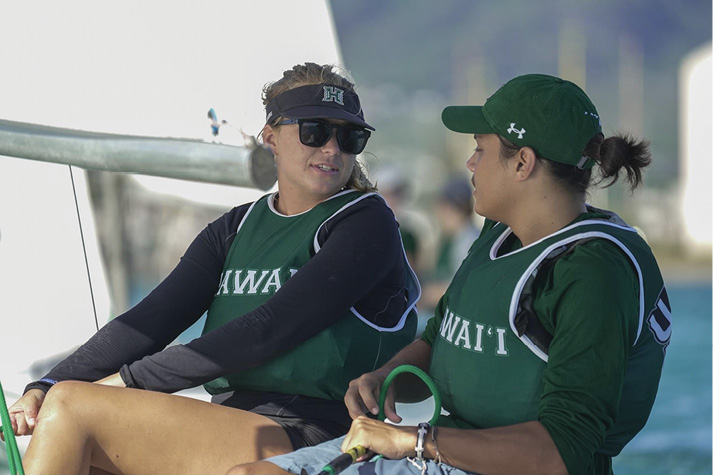
I remember when I first started as a junior sailor myself, afraid of wind and sinking and a lot more embarrassing irrational fears that I do not want to share. Since I had a great instructor and coach who believed in me, I stuck with it. Once I was of age I took over as an instructor and coach. Then I left for college and had to start working for a living, but I was always curious as to what happened to those I taught. Did they stick with sailing or switch to power boating? Either way, I knew that what I taught them would stick with them.
What happens when these kids grow up and leave their home yacht clubs and the junior programs to which they are so accustomed? Some return to sailing as adults once they are done with their careers and some continue to sail as a collegiate sailor. Sailing is a way to get a break from college classes and travel to different areas with the possibility to build lifelong friendships. In recent years I have had the privilege to watch a group of junior sailors that I taught work their way up to captain of their college sailing team, when they started out afraid to leave the dock almost a decade earlier.
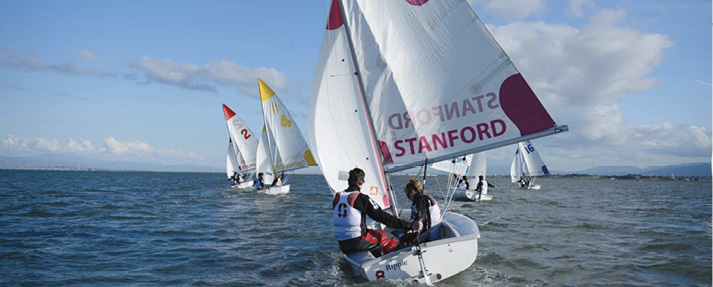
These college athletes have been back to compete a number of times, and recently the Pacific Coast Collegiate Sailing Conference brought them home for the match racing championships to the South Bay. Winds were shifty and steady at around six knots for the entire event. The hosting team of Stanford won the event and was one of two local Bay Area teams represented. The other was Cal Maritime which took fourth. Visiting to the area, the University of Hawaii and University of California at Santa Barbara took second and third. Three of the four sailors for the University of Hawaii grew up racing in the Bay Area as a part of Richmond Yacht Club’s junior program.
Collegiate sailing also brought the Stoney Burke Interconference Regatta to the San Francisco Bay area. Wind conditions over the regatta varied from light earlier in the day to stronger winds as the day progressed. The competitors enjoyed the event after being away for over a year due to the pandemic and were eager to enter into competition once again. The top three teams in the junior varsity division were two of the Cal Maritime teams and University of Washington, and for the varsity division it was University of Hawaii, University of California Santa Barbara and Cal Maritime. Most of the colleges that competed in this annual regatta came from other schools in California and out of state.
Colleges around the country offer sailing scholarships and I am always one to support academics along with a healthy relationship with sports. University of Vermont is one of the many East Coast schools that have sailing opportunities. Sports are a great way to get involved and represent the college that will be your alma mater one day.
Teaching sailors from an early age and now watching them represent their college is an experience that I am honored to have. I will always look at my students as the age they were when I met them and am always so proud of all that they accomplish on and off the water. Every summer, collegiate sailors around the country fly home and get to share their tales of the sea with their loved ones. Sometimes, like little league, sailing is a passion and not a lifelong commitment, but just like Major League Baseball the America’s Cup and Sail GP are within reach if you keep at them.
I hope that you are finding value and entertainment in my monthly column and enjoying it as much as I am writing it. Should you have anything in mind that you might wish to have covered or just to say “hey,” write me at jillian@yachtsmanmagazine.com and I will happily get back to you. Enjoy your holidays and I will be in touch next month.



